Preface
Because Superhero 2044 is a very old and rather obscure game, this article will begin with a very long preface. It’s an important game, but not very well known and even less often discussed.
As you might notice, right under this preface, I am posting a YouTube video version of this review. I’m including both versions here because I want to share this information in as many places as possible.
I have two reasons for my particular enthusiasm. First, I am a HUGE fan of superhero role playing games in general. At one time, I could honestly say I owned them all. Given the explosion of the pdf market and indie games in general, this is no longer the case but I still own a ton of superhero games. Second, as you will read in the discussion below, I was pleasantly surprised by Superhero 2044. People have often described the game as “unplayable",” but that’s not quite true. Superhero 2044 is a clear demonstration of the wild creativity of the early RPG community (a wild creativity that still exists in various corners of the hobby). More than that, it is also an example of how hard it is to create games in a chaotic environment.
Starting with this article, I will be writing a series of articles that will attempt to review and discuss most of the major superhero roleplaying games, and a couple of key supplements, that have been published over the years. I’ll alternate new and old a bit, because I want to finish my Marvel review sooner rather than later. Given that I own a large library - though sadly not all - of the superhero games that have been published to date, this should be a fun exercise. Some games that you’ll be reading about soon are Villains and Vigilantes (1st Edition) and Supergame.
Background
According to Heroic Worlds by Lawrence Schick and Steve Perrin in Different Worlds #23, Superhero 2044 by Donald Saxman is the first commercially available superhero themed role playing game. Saxman's game was initially published in 1977 under the name Superhero '44 (when I post the YouTube video I’ll share my copy). The game wasn't entitled Superhero 2044 until the game was published in a second edition by Lou Zocchi's Gamescience Inc. later the same year.
While I am a huge fan of superhero role playing games, and a student of the history of rpgs, this game sat on my bookshelf for years without a complete reading. Its lack of a list of itemized superpowers, or even mechanics of how superpowers work, was one of the key reasons that the game languished for so long on my shelf without a thorough examination. Apparently, Donald Saxman intentionally left a formal list of superpowers out of the book in order to respect the copyrights of various comic book publishers -- though that didn't stop artist Mike Cagle from providing a cover illustration filled with characters who bear an uncanny similarity to many popular comic book characters (see above).
Donald Saxman was inspired to create Superhero 2044 when he was a player in a D&D campaign run by science fiction and fantasy author John M. Ford. Ford's game featured an adventure in which, "the party of magicians and swordsmen met Batman and Doc Savage, and ultimately fought Doctor Doom and Darkseid with the help of Luke Cage and the Phantom Stranger." From that short bit of description of Ford's campaign from the Superhero 2044 rulebook, one can see how this kind of high concept mashup could inspire players to design all kinds of things. After two years of design and playtesting, and a lot of help from his friends, Donald Saxman created the Superhero 2044 role playing game. While Lawrence Schick and others have stated that the game was influenced by D&D in Different Worlds, a close reading of the game shows that few if any of those influences were mechanical. Saxman writes that one of his chief influences was GDW's early rpg En Garde and that he made a conscious effort to avoid being influenced by D&D. I own En Garde as well and I’m not quite certain how that game influenced Superhero 2044 either, except maybe by pointing towards a more theatre of the mind experience than early D&D (remember this is pre-AD&D) suggested.
Overview of the Game
Superhero 2044 begins with a description of the game universe. The majority of game play will take place on the island of Inguria, a city that is kind of a cross between Macross City and the future cities of the Legion of Superheroes. There are a number of creative influences on exhibition here and the combination results in one of the game's biggest assets, a rich world in which to play. It’s quite remarkable how much world design Saxman managed to fit into so few pages. Yes, there are a lot of granular details for GMs to fill in, but the big picture is presented in a manner that many modern games would do well to emulate.
Like many games being released around the same time Metagaming’s Melee was published the same year, Superhero 2044 features a point based character build system. In this case, players have 140 points to spend on a number of character attributes (Vigor, Stamina, Endurance, Mentality, Charisma, Ego, and Dexterity). While some of these attributes share similar names, they do have different functions and one- Stamina - would have benefited from a different name as it represents hand-to-hand fighting ability and overall physical capability. It would have been much better for Stamina to be called “Fighting” or “Melee” instead of Stamina. You’ll also note that there is no “Strength” statistic in the game. It’s interesting to note that while some modern gamers are critical of the new Marvel game because it lacks a Strength stat, the same was true of the very first superhero roleplaying game. It’s true of others as well, I’m looking at you Tiny Supers you amazingly simple and fun game. It should also be noted that players pick one of three superhero archetypes (Ubermensch, Toolmaster, and Unique) and that each of these modifies starting attributes accordingly.
While there are no "strict" minimum values to the stats, or even stated average values for the stats, there are effective minimums if you want to avoid penalties. For example if you want your character to start without any limitations or penalties, the game requires a character have a minimum of 20 Endurance, 11 Vigor, and 6 Dexterity. If any of these statistics are lower than these values, then the character suffers from some sort of penalty. Given that the Toolmaster starts with -10 points to the starting value of Endurance, a player would have to spend 30 of their starting points on Endurance to avoid any penalty. It might have been better to have the statistics start at base values and allow players to buy them down if they want to represent some disadvantage in a manner similar to what Champions adopts later.
One could, for example, have started characters with the minimum statistics I listed above as “average” and given out 103 statistic points instead of the 140 default in the rule book. Saxman might also have considered using more uniform base values for the statistics. In Champions an “average” person has a 10 in every stat, in Marvel FASERIP they have a 6 value, but in Superhero 2044 the average value is different for every statistic. All three of these critiques are issues that are quickly addressed by other superhero rpg designs, for point based systems anyway. Given that Wayne Shaw’s house rules for Superhero 2044 were one of the inspirations for Champions, one can hypothesize that the design choices of that game were a direct result of similar thoughts by Shaw.
Once these initial points are spent, the players are allowed 50 bonus points to add to one of these in special circumstances in order to emulate some power. The example given is 50 extra Endurance vs. Bullets and some recommendations are made to base super powers on weapons and gadgets contained in the game.
Episode 155: Wayne Shaw Discusses the History of Superhero Role Playing Games
Though there is a point based system for the purchase of attributes, there is no such system for super powers. Donald Saxman had intended to write three books for he Superhero 2044 system in which one of the later books would provide such a system, but those books were never published. This doesn't mean that no power design rules were ever published. Wayne Shaw - who I interviewed on the Geekerati podcast (above) - wrote an extensive super power design rules set in issue 8 of Niall Shapero's excellent The Lords of Chaos fanzine. Shaw also offers some ideas in the insert to the 2010 reprint of Superhero 2044 mentioned earlier.
Importance to the Genre
As I mentioned before, the lack of a super power design system meant that this the game sat on my shelf for some time. When I finally too the time to read the book, I found it to be much better than I expected. While I would argue that without Wayne Shaw's additions in The Lords of Chaos issue 8 the game would be challenging to run, if Superhero 2044 had never been published the modern super hero role playing would not be what it is today. The game has had wide reaching on the super hero games that came after it. If not for Superhero 2044, there would be no Champions, Supergame, Golden Heroes, or even (I’d argue) the new Marvel Multiverse Roleplaying Game. Each of those super hero games lifts a concept out of Superhero 2044 and incorporates it into design.
Superhero 2044 is more than the first super hero role playing game, it is the foundation upon which many games followed.
While it wasn’t the absolute first point based game, it was the first superhero game to include point based character construction. Though the point expenditure was limited to the building of a character's "attributes" and were not a part of "power design," this was still a major shift in game design. This innovation in particular is one of the major design starting points for a number of super hero role playing games -- not the least of which is the Champions game.
Earlier I mentioned that the Champions roleplaying game was an off-shoot of Wayne Shaw’s house rules for Superhero 2044 and you may be wondering, “just where is Christian getting this information? Sounds made up to me.” Well, the first edition Champions rule book specifically mentions the influence that Wayne Shaw's character creation rules had on the game's early design, but the influence Superhero 2044 had on Champions reached beyond having a point based character design system. It also influenced the combat system.
Influence on Champions' Combat System
In addition to being inspired by the point based character design of Superhero 2044 it is evident that Champions melee combat system was influenced by Donald Saxman's game as well.
In Champions combat is resolved by taking a character's "Offensive Combat Value" and subtracting an opponent's "Defensive Combat Value." The result of that subtraction is then added to 11 to find the number required to hit an opponent on a roll of 3 six-sided dice. Champions combat system is one of the best on the market and the fact that it uses a comparison of combatant's effectiveness, and a bell curve resolution system, are among its chief strengths. As you will see in a future review, the new Marvel Multiverse Role Playing Game does something similar, though it streamlines the process.
In Superhero 2044, you take a character's "Stamina" and subtract his opponents "Stamina." The difference between these two numbers is compared to the Universal Combat Matrix which gives you a number between 3 and 18 that the character must roll on 3 six-sided dice to determine if the character hit his opponent. It should be noted that this combat system is only used for "melee" combat in Superhero 2044, where it forms the foundation of Champions combat.
The Champions version is more elegant, as the result of the initial comparison is the modifier to the 3d6 roll, but it is the same system. It is as if the designers of Champions play tested and refined the Superhero 2044 melee combat system. Champions combat has some significant differences overall to Superhero 2044, but one can see that one echoes the other.
Influence on Supergame
Like Champions, Supergame was influenced by Superhero 2044's point based character generation system. Given its own 1980 design date, and the fact that it was a part of "California Gaming Culture," might hint that Supergame itself also influenced Champions. One sees the underpinnings of Superhero 2044 is in the purchase of a character's starting attributes.
Both Superhero 2044 and Supergame feature something that many modern gamers might consider odd. All of a character's attributes start at zero and can be increased -- this itself isn't odd to the modern gamer. What is odd is that both games have attribute levels where the character is suffering from a disability. In Superhero 2044, if a character has an Endurance of less than 20 that character is "fatigued" or worse. In Supergame, a character with an "Agony Score" of less than 15 "may either move or attack, but only one per turn." There are similar penalties for "Vigor" in Superhero 2044 and "Physical Score" in Supergame. The names of the attributes and the level of effect are different, but one can see the similarities. Most modern systems would start a character with a base number of points sufficient to not be fatigued or incapacitated, but both Superhero 2044 and Supergame allow for the possibility.
But it isn't the point based character design where Supergame bears the most similarity to its predecessor. Supergame includes rules for building specific powers -- though not as robust the later published Champions -- that are themselves an innovation over the state of gaming at that time and a step beyond what were offered in Superhero 2044.
The area where Supergame most reflects Superhero 2044 is in its ranged combat system. In Superhero 2044, ranged combat is decided by rolling a six sided die and adding/subtracting to the die total applicable modifiers. This sets the target number that must be rolled, or higher, on a second roll of a six sided die. For example a character with a 20 Dexterity (-1) shooting an opponent at point blank range (-3) with a shoulder weapon (-1) rolls a 6 on a six sided die. This gives a modified result of 1 (6-1-3-1=1) and means that the character hits if the player rolls a 1 or better on the second roll. This system, with some differences in modifier values, is the system used in Supergame.
I swear that this system (roll to get target number, then roll with modifier to see if you hit) seems really familiar to me. I’m sure I’ve encountered it elsewhere, likely in wargaming circles, but I cannot for the life of me remember or find it anywhere else.
Influence on Golden Heroes
While I was intrigued by the way that Superhero 2044 influenced the design of American super hero role playing games, I was amazed at how it had influenced a British one. In White Dwarf magazine issue 9, game designer Eamon Bloomfield reviewed Superhero 44 -- Superhero 2044's first edition -- and wrote the following:
The weekly planning sheet is one of the most intriguing aspects of the Superhero 2044 game and the most playable aspect "out of the box." The game includes weekly planning sheets that provide a number of "activity blocks" to which players assign particular tasks, like fighting crime or resting. Golden Heroes, Games Workshop's super hero role playing game, featured a campaign system that bears no small similarities to that of Superhero 2044. Games Workshop was, and still is, the publisher of White Dwarf magazine and so it is easy to believe that this game review sparked some discussion of "planning sheet" style campaign play.
Golden Heroes by Simon Burley features a campaign system that heavily relies on something very similar to Superhero 2044's weekly planning sheet. They have a system that uses something called a "Daily Utility Phase" or DUPs. The game describes them as follows:
The scenarios played in each week occupy a certain number of DUPs for the characters involved. Any remaining DUPs can be devoted to other pursuits such as training, improving powers, developing scientific gadgets, etc.
Thus at the end of each scenario, you must inform the players how many spare DUPs their characters have. Preferably then, or at worst at the start of the next game session, the players must tell you how their characters have spent those DUPs.
The player's allocation of DUPs is compared to various campaign ratings, something vary similar to what Superhero 2044 calls "handicaps," in order to determine what events happen to the character and how much the character is able to improve over time. Both systems are dynamic and change as characters interact with the game world. The Golden Heroes system is more developed and is a part of a more complete system of mechanics, but it is unarguably a descendant of the Superhero 2044 system.
Closing Remarks
I wish I had read Superhero 2044 much sooner than I did. It is a definite diamond in the rough. While it would be difficult to play RAW, it has a large number of innovative mechanics and ideas. Even more surprisingly, the game is actually playable. The underlying game mechanics are solid. It’s the character creation bit that needs a lot of work. Regardless, the fact that it contains enough ideas to influence no fewer than THREE super hero role playing games in their design is a significant achievement in and of itself. One cannot truly understand the development of the hobby without reading this game.
I think I will try to play the game itself soon, though I don't know if I will try to design a comprehensive powers system or use an existing one to supplement the game, as the campaign play system still stands out as something that has some depth and would be useful in a number of games. Given the abstract nature of the campaign planning system, one could easily adapt it to another game for use.
The game also features a detailed setting for super hero play. The setting lacks the microscopic detail of modern settings, but for the time the game was written it is quite intricate. Like the game itself, its setting is one that inspires addition and extension rather than provides a complete painting.
Donald Saxman created something pretty special and I'd love to see someone take this system and make a modern edition out of it. It would take some work, but it would be worth it.
There is currently an updated version of Superhero 2044 being slowly but surely designed as I write this. It was launched as a Kickstarter, but the death of the hired designer (Steve Perrin) and other potholes have long delayed the project. Many think the game will never see the light of day, but I disagree. I think the new edition will eventually be completed, but I have no idea when. I backed that Kickstarter and have the playtest rules, so I know it can be finished. It just has to make it over the final finish line.
That said, I wish I had personally asked Donald Saxman while he was alive if he would have agreed to work with me to run a Kickstarter of Superhero 2044 Second Edition that incorporates some of Shaw's changes while keeping the basic system as is. Such an endeavor would have been a truly OSR adventure and one that I think would have been worth exploring. I would have asked some of my experienced designer friends if they wanted to jump on board as well.
What would a more developed version of the original game look like? I hope we get to find out some day.
For more information about the early days of superhero roleplaying games, the Age of Ravens blog has written a series on the History of Superhero RPGs that gives brief synopses of these games through the ages and James Maliszewski has published an essay by Superhero 2044 creator Donald Saxman. The Saxman essay, along with an old post I wrote on Cinerati in 2010, were included as additional materials in a 2010 reprint edition of Superhero 2044 issued by Gamescience.





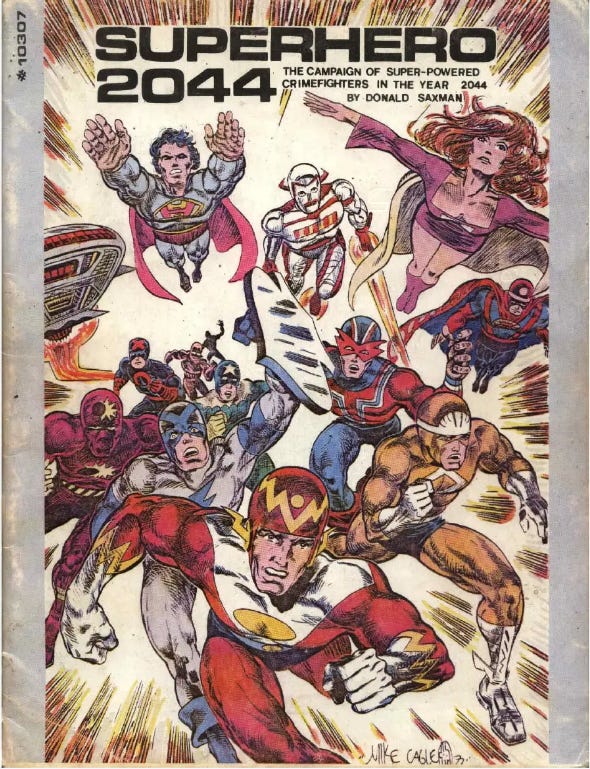
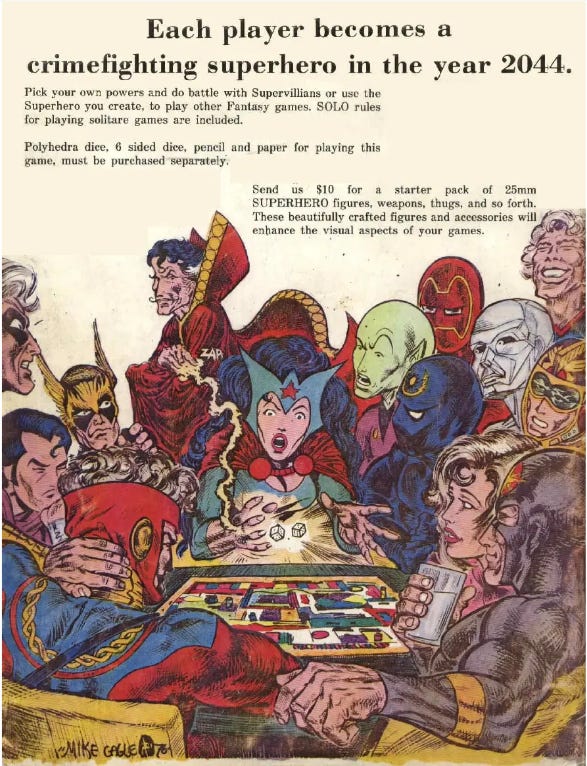
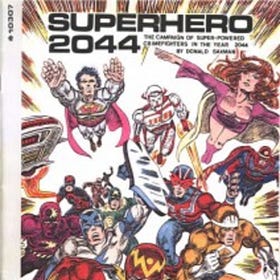
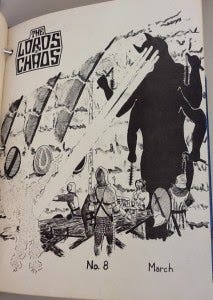
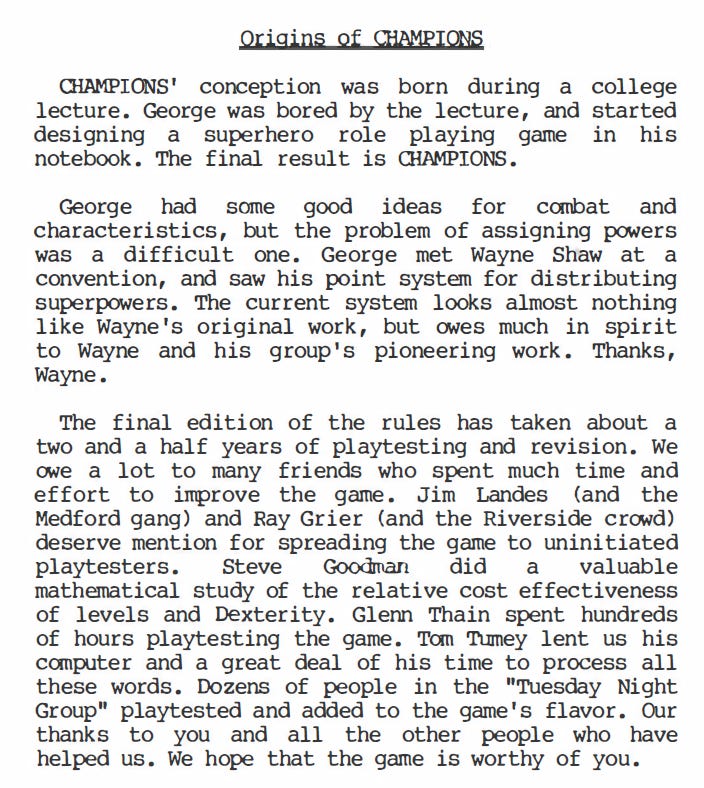


I can only imagine all of the edgy heroes and anti-heroes that would've been created in this age
"I swear that this system (roll to get target number, then roll with modifier to see if you hit) seems really familiar to me. I’m sure I’ve encountered it elsewhere, likely in wargaming circles, but I cannot for the life of me remember or find it anywhere else."
I have the same feeling of deja vu. Might it have been something like Starfleet Battles, or one of the Steve Jackson games like Car Wars?